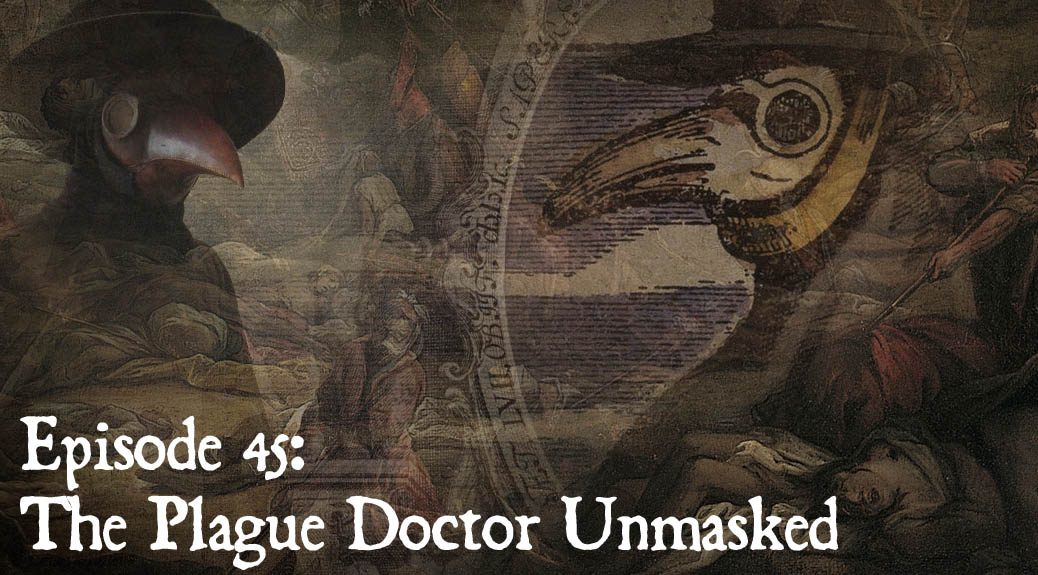
The Plague Doctor Unmasked
Podcast: Play in new window | Download (Duration: 46:50 — 53.6MB)
Subscribe: Apple Podcasts | Spotify | Android | Podchaser | RSS | More
The figure of the masked plague doctor is an object of intense fascination but also the subject of much misinformation. This episode sorts things out while seeking particular evidence for such handsomely dressed character in the historical record.
We begin with a few clips from horror films in which plague doctors figure, including the 2008 film The Sick House in which the spirit of a plague doctor menaces an archeologist, and the 2019 film The Cleansing in which a malevolent bird-masked “Cleanser” stalks through 14th-century Wales.
As most listeners are somewhat familiar with the plague mask and its presumed function, we get that out of the way first, noting the mask’s connection to the antique belief in miasma, or disease-carrying air as the cause of the plague and other ailments. We also clear up the misunderstanding that the plague doctor is a medieval character (since he only appears in the 17th century).
His first appearance is in a German broadsheet from 1655, in which the crow-like character identified as “Dr. Beak” and lampooned (along with doctors in general) for being greedy as carrion crows. As this image was copied and recopied for centuries, it raises the question as to whether the birdlike mask was in fact drawn from life or created strictly in the service of this original broadsheet’s metaphor.

Next we look at other evidence for the character in the form of actual artifacts, including two masks exhibited in museums in Berlin and Ingolstadt, Germany.

As there are reasons to doubt the authenticity of these, we next look at evidence of plague masks associated with the island of Poveglia in the Venice Lagoon. Along the way, we learn a bit more about early measures the city took against the plague (including the invention of the concept of shipping quarantines along with coinage of the word).
We also review a bit of general information about the islands in the Venetian lagoon (including others besides Poveglia) used for the clinical isolation of victims of plague, leprosy, and the mental illness. A photo taken on Poveglia in 1899 is discussed as it may show an actual plague mask in use in the late 19th century. We also hear some snippets from the TV Show Ghost Adventures, which popularized a number of legends associated with Poveglia, including tales of asylum torture and suicide.

Next, we look at the first textual evidence for this plague mask and suit, in a 1682 volume attributing its invention to Charles de Lorme, royal physician to Louis XIV and the Medici Family, among others.
While the design of the mask seems to be a first with de Lorme, we also hear of some other uses of protective plague garments are documented in France and Italy around this time.
A surprising example from Basel, Switzerland provides rare evidence of particular doctor known to have worn a plague suit and mask. It’s 17th century painting of the family arms of the Zwinger family of Basel, painted for the doctor and theologian Theodor Zwinger the Younger, and depicting him in a plague mask and suit.

We also have a look at the symbolic use of special historic plague garments, special colors worn in France and Italy for medics working with plague victims, and the symbolic and practical function of the stick or baton held by the the plague doctor in most every historical illustration.
The Great Plague of Marseille (1721 to 1722) provides us one more name of a doctor known to have worn a plague suit and mask. His name was François Chicoyneau, and his efforts were not well received by the citizens he was assigned to serve in Marseille, as we hear.
Along the way, Mrs. Karswell provides us some contemporary accounts documenting other aspects of the Marseilles plague, the last bubonic pandemic of Europe, including novel means of disposing of plague corpses considered by the town council, a curiously relevant form of social distancing, and the basis of the legend of “Four Thieves Vinegar.”
Finally, we discuss those plague doctor masks worn in the Venetian Carnival, learning that they are a strictly modern creation not associated with the 16th-18th century commedia della’arte tradition that gives us the other masks.
We end with a strange parallel between an opera about performers in the commedia della’arte and a 1928 film starring silent horror great Lon Chaney, Sr. Included is a bit of music used to promote the film in question, Laugh Clown, Laugh.”
